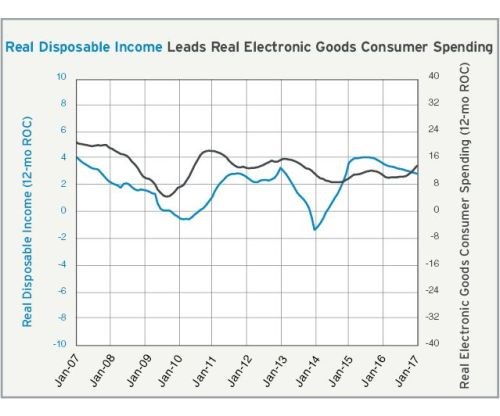Appliances and Electronics
Appliance production growth should slow this year, but is electronics production poised to grow faster?

Appliance Production Growth Should Slow in 2017
The real 10-year treasury rate was 1.23 percent in December 2016, an increase of 24 basis points from the previous month. This was the highest this rate has been since April 2016. The nominal rate was 249 basis points, which was the highest since September 2014. However, the rate of inflation has been rising, too. In December, inflation was more than 2 percent for the first time since June 2014, and this increase has been limiting the rise in the real 10-year treasury rate (the real rate is the nominal rate minus inflation). The year-over-year change in the real rate increased to -89 basis points in the month, the second straight showing an increase in the year-over-year change. This should lead to a decline in housing permits.
There were 90,000 housing permits filed in December; this was the lowest level since February 2016. Compared with one year earlier, housing permits decreased 7.0 percent. This was the first month of contraction since July 2016 and the second fastest month of contraction since April 2011. The annual rate of growth decelerated to 0.1 percent, its slowest rate of growth since September 2011, which was the last time the annual rate of change contracted. The growth rate in housing permits decelerated sharply in 2016 and is likely to contract in 2017.
Housing permits are a reasonably good leading indicator of appliance production simply because new homes require many new appliances. The trend in appliances was accelerating growth in the second half of 2016. In looking at the correlation between housing permits and appliance production in the chart above, it appears that growth in appliance production should slow significantly this year (as would be indicated by the black line moving down on the chart).

Electronics Production Poised to Grow Faster
In December, real disposable income grew 2.1 percent over one year earlier. This was the slowest rate of month-over-month growth since January 2014. The month-over-month rate of growth was less than 3.0 percent in 10 of the previous 11 months. The annual rate of growth has decelerated steadily since August 2015, and in December it hit 2.7 percent, which was the slowest rate since October 2014. Also, this was the sixth month in a row that the annual rate of growth was less than the historical average of 3.1 percent.
Despite the slower growth in disposable income, consumer electronics spending accelerated rapidly in the second half of 2016. Compared with one year earlier, December’s electronics spending increased 18.5 percent, which was the fastest rate of growth since August 2010. However, the trend of decelerating income at the same time as accelerating growth in electronics spending looks wrong when placed in the historical context of the last 40 years (see the chart to the right). Therefore, while it is possible that electronics production could see accelerating growth in 2017, I would hedge my bets on that.
Related Content
-
From Injection Mold Venting to Runnerless Micro Molds: MMT's Top-Viewed June Content
The MoldMaking Technology team has compiled a list of the top-viewed June content based on analytics. This month, we covered an array of topics including injection mold venting, business strategies and runnerless micro molds. Take a look at what you might have missed!
-
Women Impacting Moldmaking
Honoring female makers, innovators and leaders who are influencing our industry's future.
-
Steps for Determining Better Mold Prices
Improving your mold pricing requires a deeper understanding of your business.
_970x90 3.png;maxWidth=970;quality=90)
.JPG;width=70;height=70;mode=crop)














